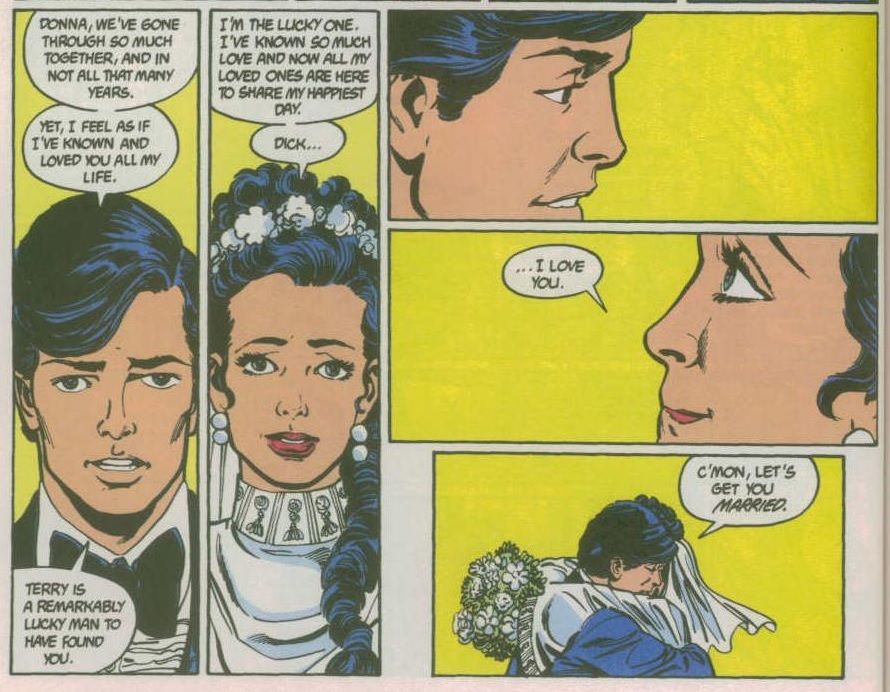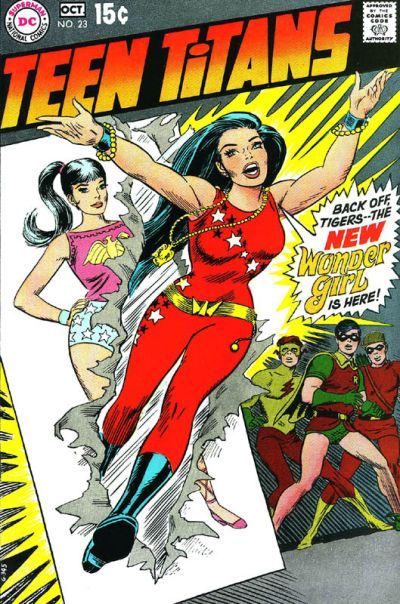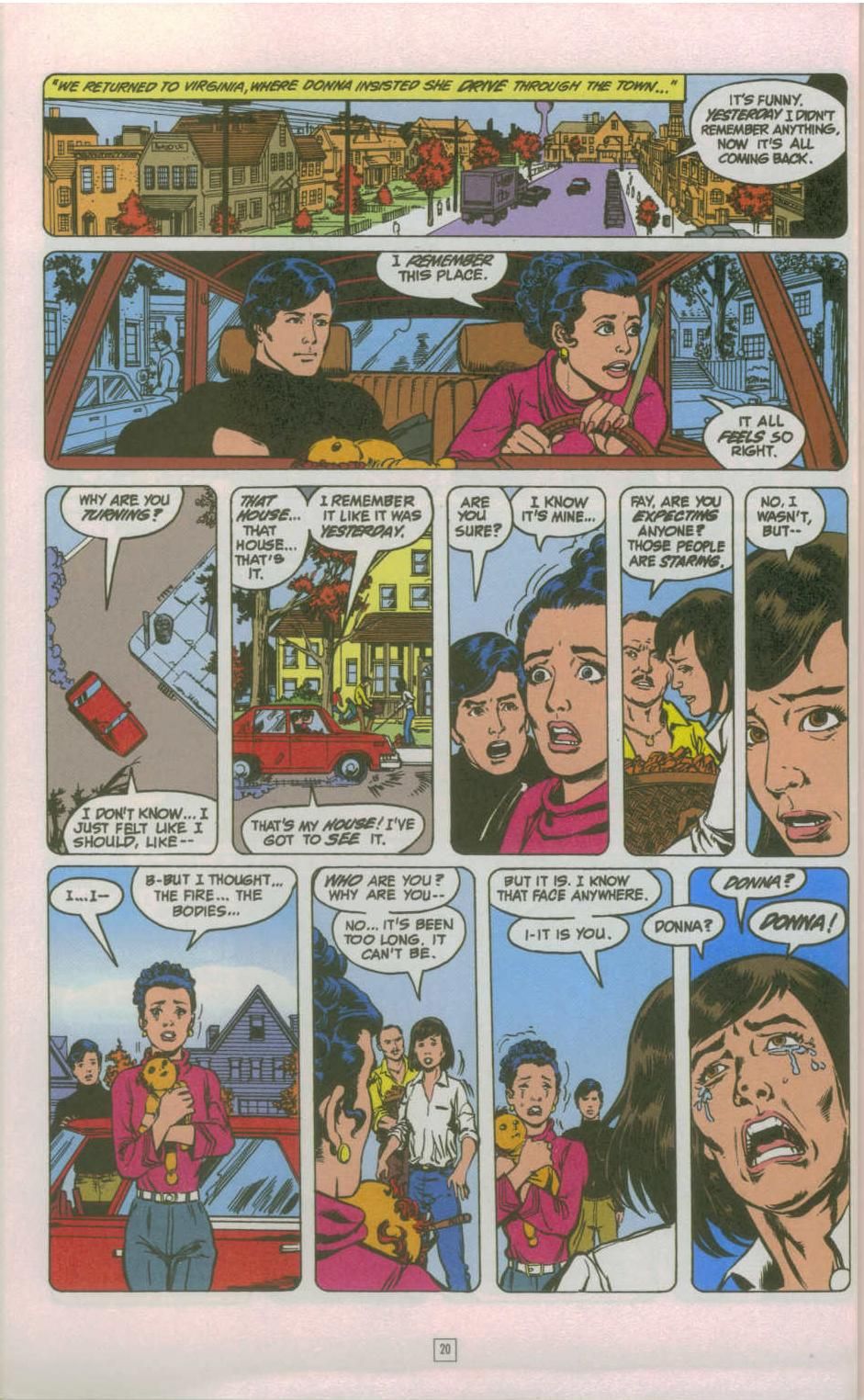Thanks to Tom Spurgeon, I read a fascinating article about “using Graph Theory to create a digital model of the whole of Marvel continuity,” from comics to TV and the current crop of movies. It maps out connections among characters -- unsurprisingly, the three big groups relate to the X-Men, the Avengers, and Spider-Man -- but it also discusses exceptions to characters’ defining traits. For example, Hawkeye is Clint Barton (or not), who is an archer (most of the time) and an Avenger (except when he’s a Thunderbolt). Marvel appears to be using this model to answer basic questions like “who is that?” and “how does s/he relate to this over here?” -- with an ultimate goal of getting fans of its movies and TV shows to try the comics.
As you might imagine, this sort of analysis would have been ideal for the pre-New-52 status quo, whose five generations of characters (going from the original Justice Society to Damian Wayne) included many with multiple code names. Chief among these were the original Teen Titans who, following the examples of Dick Grayson and Wally West, graduated from sidekicks to “grownup” superheroes. Initially, logistical concerns facilitated these changeovers (we need a new Robin; we need a new Flash) -- but in terms of the intersection of continuity and character development, none of the Titans had quite as much on her résumé as Donna Troy.
* * *
Now, before you click away for fear of catching continuity cooties, rest assured I’m not going to go too deep into Donna’s history. This is why we have Wikipedia and great comprehensive fansites like Titans’ Tower. However, I do want to highlight the quirks of her Silver Age origins. Initially, Wonder Girl wasn’t a separate character, but a manifestation of Wonder Woman as a teenager. Just as there were “Superboy” stories about the teenaged Kal-El, there were “Wonder Girl” stories featuring teenaged Diana. Teen Diana eventually had several team-ups with Baby Diana (aka Wonder Tot) and Wonder Woman, which is probably a shining example of Silver Age Crazy. More to the point, though, it helped establish Wonder Girl as her own person, which is basically what got her into the Teen Titans.
The prototypical Teen Titans story featured Robin, Kid Flash and Aqualad (who weren’t called the Teen Titans at that point), and appeared in The Brave and the Bold #54 (June-July 1964). Bob Haney wrote and Bruno Premani drew both that story and its follow-up, the first proper Titans tale from B&B #60 (June-July 1965). Wonder Girl appeared in the latter, but as Wonder Woman’s sister, not her teenaged self. I always understood this to be a mistake on the part of Haney and/or editor George Kashdan, but clearly it was a happy accident.
While the Titans soon got their own title, Wonder Girl would have to wait until August 1969's Teen Titans #22 for not just an actual origin, but a real name. For four years her only other appellation had been “Wonder Chick,” so scripter Marv Wolfman (working with editor Dick Giordano) named her Donna Troy. Seems that Wonder Woman had rescued the orphaned Donna from a burning building and taken her to Paradise Island, where she’d gotten super-powers from the magical Purple Healing Ray. Raised as Diana’s little sister, Queen Hippolyte had sent her to Man’s World just in time to join the Titans -- but not having any other identity, or anywhere else to go, she’d been sleeping in the Titans’ headquarters. That changed posthaste, as the guys helped Donna find a roommate and move into an apartment. Artists Gil Kane and Nick Cardy further marked her independence by giving her a new costume and hairdo. The look lasted for almost 20 years, and it’s made a comeback as part of the Super Best Friends Forever! animated shorts.
Let’s stop there for a minute. Going back to the aforementioned Hawkeye example, we could say that Donna Troy is Wonder Girl, Wonder Woman’s kid sister, and has all of Wonder Woman’s powers ... except when one or more of those things aren’t true. Donna eventually developed a number of “exceptions,” along with various complications added to her basic origin. Essentially, she got complicated because DC let her get complicated, and DC let her get complicated because it wanted to keep her around. By 2003 DC had had enough, so it killed her off; but she returned two years later in a miniseries produced by reverent professionals. Not bad for a character who owed her existence to a misunderstanding of Silver Age Crazy, and who got by for her first four years without her own origin, secret identity, or place to live.
Still, I have to think that those unique circumstances helped endear Donna to fans and pros alike. Wonder Girl was never the sidekick that Robin, Kid Flash, Speedy or Aqualad were, mostly because she developed the most as a Teen Titan. For most of the group’s early years, she was the only female Titan, which put her in the “only girl in the clubhouse” role. It was kind of like New Girl, except Jess had no other friends, no job except hanging out with the guys and fighting crime, and was drawn to doe-eyed perfection by the late Cardy. Wolfman scripted her first origin story, and expanded on it 15 years later in the unforgettable New Teen Titans #38, emphasizing -- consciously or not -- both that her past made her special, and that her guy friends were helping her deal with it. (In 1969 the Titans helped her get on her feet, and in 1984 Robin’s detective work uncovered her family’s history.) This is perhaps not the most empowering way to view Donna, but it allowed readers to participate more fully in her various journeys of discovery.
It helped that when New Teen Titans came along, Wolfman and artist/eventual co-plotter George Pérez saw Donna as one of the more normal, down-to-earth Titans. This was probably unavoidable: Robin wanted independence, Kid Flash and Cyborg were reluctant superheroes, Changeling was egotistical, Starfire was a free spirit, and Raven struggled against her evil side. Sure, Donna was a 19-year-old partner in a photography studio, her boyfriend was a smarmy community-college professor pushing 30 and already divorced, and she lived in a glamorous apartment financed by Queen Hippolyte -- but she was still relatable. Wolfman set up her curiosity about her past up front, in NTT #1 (November 1980) and let the subplot percolate for more than three years. Ultimately, January 1984's “Who Is Donna Troy?” (NTT #38) told the story of Dorothy Hinckley, who gave up baby Donna for adoption; Fay Stacey, who adopted Donna but couldn’t afford to keep her; and the child-smuggling racket which, but for that building fire, would have ensnared her. A beaten-up little doll with a “Hello My Name Is Donna” sign tied it all together, and Pérez brought it home with a masterful sequence of panels and expressions which took Donna from anticipatory glee to total emotional collapse. Having the doll reappear in the epilogue, fixed up good as new, probably got some tear stains on a fair amount of issues.
A year later, Donna and Terry got married in the extra-sized Tales of the Teen Titans #50. This was the emotional peak of the Wolfman/Pérez run, not least because it featured more great character moments, particularly between Donna and Dick (who walked her down the aisle). It was an issue that acknowledged, and celebrated, the fans’ and creative team’s love for these characters, and it’s still pretty great.
(Yes, even with Terry.)
Since then, various writers and artists have tried to recapture that old Wolfman/Pérez touch. These have included the duo themselves, in a 1988-89 continuity-patch arc called “Who Is Wonder Girl?” (New Titans #s 50-55); fans-turned-pros Devin Grayson and Phil Jimenez reuniting the original Titans in the 1998 JLA/Titans miniseries; and Jimenez writing, José Luis Garcia-Lopéz penciling, and Pérez inking the 2005 Return of Donna Troy miniseries. In the ‘90s she gave up her powers to stop her baby from growing up to be a super-powered dictator, and then she became Kyle Rayner’s girlfriend. John Byrne revised her origin so that every Hypertime version of her would be miserable, and that was resolved when Hippolyta, Diana and Wally West used their memories to “rebuild” her. Some years after Terry divorced her, he and their child died in an off-screen car crash; and Donna’s (apparent) death was at the hands of a rogue Superman robot. It was all well-intentioned, but for the most part it didn’t come across that well, and cumulatively it gave Donna the reputation for impenetrability she enjoys today.
* * *
Of course, today Donna is in limbo, not having made the New 52 cut. DC’s mission with the New 52 was to simplify, simplify, simplify; and clearly Donna wasn’t deemed either necessary or simple. (For whatever it’s worth, I could easily see the New 52 Wonder Woman rescuing infant Donna, etc., although the origin might be viewed a little differently in light of the Amazons’ revised history.) However, as mentioned above, she’s shown up on Super Best Friends Forever! in her Kane/Cardy outfit, so it’s not like she can’t be simplified.
Again, though, I theorize that Donna’s popularity encouraged the various creative teams to try and keep her around, through the assorted plot machinations and soft revamps listed above. James Robinson putting her in Justice League of America (alongside best bud Dick “Batman” Grayson) might have been the last attempt in the comics for a while, because I’m not sure there are enough pros out there who’d want to bring her back. “Who Is Donna Troy?” is 30 years old, and “Who Is Wonder Girl?” turns 25 this winter. There may still be a lot of affection for the Wolfman/Pérez Titans, but with every passing year they turn more into nostalgia fodder.
Even so, could a computer model help give Donna a new lease on life? That’s hard to say -- but I suspect the answer has to do with whether DC would use such a road map to lead new readers into the thickets of its old continuity, or give them a quick and easy way out. Both the Marvel movies and DC’s TV shows (live-action and animated) have done a good job of balancing accessibility against comics-based continuity, so there are a few “ways in” already. If today’s readers are looking for someone who’s relatively well-adjusted, who ties into decades of DC history, and whose own story was often pretty compelling, they could do worse than following our pal Donna.
However, these days that may not be the point. I hate to sound all “kids today, with their gadgets,” but Donna’s travails were part and parcel of a serialization style that wasn’t that concerned with being collected. I think New Teen Titans is ideal for e-reading, because there are so many subplots playing out (and paying off), particularly over the four-plus years of Wolfman/Pérez. By the same token, the individual issues are so packed with portent that it’s entirely possible to see the whole run as overwrought, if not self-important. Whether that’s something today’s younger readers could get past, I have no idea. If not, Donna may live on only in those back issues, a perfectly nice character doomed by her own longevity.



